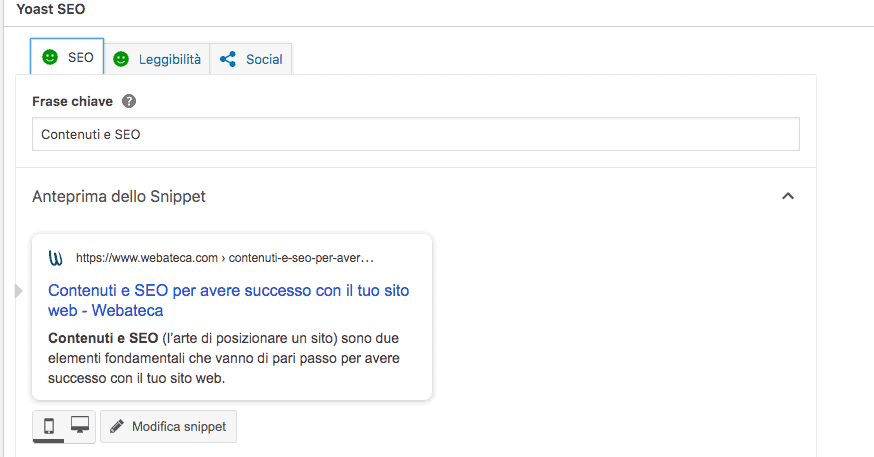Content and SEO to be successful with your website
Content and SEO are two fundamental elements that go hand in hand to be successful with your website.
Content marketing is the strategy that allows, through SEO (the art of positioning a site), to reach potential customers. In reality, it is the latter who will land on your site since the SEO will direct them to consult your content to find the best answers they are looking for.
Obviously you have to offer quality in your texts and above all know how to structure them in such a way as to be “chosen” by search engines.
To create a site we use platforms such as WordPress, a content management system that has a SEO section dedicated to optimization. Exploiting the resources of this software means creating the way to the success of your site.

However, this is not enough, since you are not the only one on the net and to stand out from the competition you have to “conquer” the most used engines like Google by working hard and correctly.
Are you wondering how to do it? Stay with us and read on to find out how to attract customers to your website and retain them.
3 fundamental elements contained in a successful website
A mistake that is commonly made when building a website is writing content before reflecting on SEO optimization.
Following this process causes a great waste of time and money, as many find themselves having to change pages and even rewrite pieces of content.
Everything revolves around your audience: knowing their language is the key to success in optimizing SEO content.
And it is precisely on the study done on readers that the following elements are developed that lead a site to be consulted by a large number of people and consequently well positioned online.
Keywords
It is very important to include the right keywords on your website. The right words are those used by your audience during a search, which is why we affirmed the importance of knowing your target before creating content. Find the keywords people use when they search, know their needs and provide answers to their concerns using their language format. Be careful not to repeat the same terms too much, as search engines are intelligent and can recognize synonyms, plurals, abbreviations, etc. Keywords must be inserted in texts, titles, descriptions, subtitles, images and even in the URL.
Call to action
Your content is flawless, but have you entered a call to action? The call to action has the role of directing readers to take action at the end of the reading. The public, after consulting the information they were looking for, must be clear about the next step to take in order not to be in a position of uncertainty and be pushed to leave your site. For this reason, a button is added to click to take you to another page to consult or directly to the online store.
Social Networks
Knowing your audience means finding yourself where they are. Social networks are now a precious resource made available on the market and that companies must exploit to disseminate their content more. Therefore, social sharing buttons are one of the most important content of a successful website. Through these buttons, readers are given the opportunity to be able to share what you offer on their profiles to a wider community. They must be inserted at the beginning and at the end of each content.
Now look with us for any technical issues that are preventing a site from being successful.
Content and SEO: the technical aspects
#1 Upload Speed: Each content should not exceed 3 seconds while uploading.
#2 Responsive site: verify that the contents are displayed correctly on mobile devices and that the CTAs are viewed correctly. Remember that the site, in addition to being responsive, must be optimized for mobile indexing.
#3 URL: The URLs used must be short and descriptive.
#4 Sitemap: create a sitemap (a map of your site) to insert within your website and provide a sitemap.xml file to search engines, so that they can best index all pages.
#5 Links: Verify that links to content are performed correctly without interruptions, i.e. avoid error pages or nonexistent pages.
READ MORE
-
 Content creation? How to be first on Google with SEO- 08/09/19
Content creation? How to be first on Google with SEO- 08/09/19 -
 How to write content for the website- 04/11/19
How to write content for the website- 04/11/19 -
 Website optimized for mobile, it is the solution that will help increase sales- 04/11/19
Website optimized for mobile, it is the solution that will help increase sales- 04/11/19 -
 Why is it useful to have a mobile app?- 04/11/19
Why is it useful to have a mobile app?- 04/11/19 -
 The content must be optimized for mobile. Let’s find out how!- 04/11/19
The content must be optimized for mobile. Let’s find out how!- 04/11/19 -
 Do you want to know what the ideal structure of a website is?- 04/11/19
Do you want to know what the ideal structure of a website is?- 04/11/19 -
 Website and mobile app: the winning combination- 04/11/19
Website and mobile app: the winning combination- 04/11/19 -
 How to create a content editorial plan for the website- 04/11/19
How to create a content editorial plan for the website- 04/11/19 -
 Increasing the visibility of a website is possible by opening a blog- 04/11/19
Increasing the visibility of a website is possible by opening a blog- 04/11/19 -
 How to write content for website promotion on Google Ads- 04/11/19
How to write content for website promotion on Google Ads- 04/11/19 -
 Why is content on a website so important?- 26/11/19
Why is content on a website so important?- 26/11/19 -
 How to improve website performance- 28/11/19
How to improve website performance- 28/11/19 -
 Improve the indexing of the website with the blog- 03/12/19
Improve the indexing of the website with the blog- 03/12/19 -
 All the ways to increase website visitors- 05/12/19
All the ways to increase website visitors- 05/12/19 -
 Structure and form: optimization of the mobile website- 10/12/19
Structure and form: optimization of the mobile website- 10/12/19 -
 How important can an optimized mobile app be for your company?- 17/12/19
How important can an optimized mobile app be for your company?- 17/12/19 -
 Not just a website: the mobile app can be one of the tools to increase the visibility of your company- 24/12/19
Not just a website: the mobile app can be one of the tools to increase the visibility of your company- 24/12/19 -
 Finding new customers- 14/04/22
Finding new customers- 14/04/22 -
 Web Agency- 13/04/22
Web Agency- 13/04/22 -
 Online visibility- 11/04/22
Online visibility- 11/04/22 -
 Mobile App Developers- 20/04/22
Mobile App Developers- 20/04/22 -
 Internet for PR- 02/09/22
Internet for PR- 02/09/22 -
 Create mobile apps- 25/04/22
Create mobile apps- 25/04/22 -
 Importance of mobile apps- 26/04/22
Importance of mobile apps- 26/04/22 -
 How to get the user’s attention through content- 26/04/22
How to get the user’s attention through content- 26/04/22 -
 The basic rules for writing content- 26/04/22
The basic rules for writing content- 26/04/22 -
 Sponsor your site: how the content posted can help you- 26/04/22
Sponsor your site: how the content posted can help you- 26/04/22 -
 How to create an effective editorial plan to increase visits- 26/04/22
How to create an effective editorial plan to increase visits- 26/04/22 -
 Mobile vs Desktop how content changes- 25/04/22
Mobile vs Desktop how content changes- 25/04/22 -
 How does site speed affect indexing?- 25/04/22
How does site speed affect indexing?- 25/04/22 -
 Leads and Google Ads: how to increase website traffic- 25/04/22
Leads and Google Ads: how to increase website traffic- 25/04/22 -
 The 2 principles that make desktop browsing easier- 24/04/22
The 2 principles that make desktop browsing easier- 24/04/22 -
 6 fundamental things that make it easier for users to make purchases from mobile- 24/04/22
6 fundamental things that make it easier for users to make purchases from mobile- 24/04/22 -
 Smart Working, funding opportunities- 20/04/22
Smart Working, funding opportunities- 20/04/22 -
 Here’s how to optimize performance through content for your customers’ sites- 18/04/22
Here’s how to optimize performance through content for your customers’ sites- 18/04/22 -
 iOS and Android how to create an app- 18/04/22
iOS and Android how to create an app- 18/04/22 -
 Promote your mobile app: here are the useful tools- 15/04/22
Promote your mobile app: here are the useful tools- 15/04/22 -
 Telemaco case history mobile app- 15/04/22
Telemaco case history mobile app- 15/04/22 -
 Pros and cons of having a site optimized for every screen- 14/04/22
Pros and cons of having a site optimized for every screen- 14/04/22 -
 How content marketing for service companies can be helpful- 14/04/22
How content marketing for service companies can be helpful- 14/04/22 -
 3 Elements to Keep in Mind When Creating Content for the Website of your client- 12/04/22
3 Elements to Keep in Mind When Creating Content for the Website of your client- 12/04/22 -
 Content creation for mobile! The rules to follow.- 08/04/22
Content creation for mobile! The rules to follow.- 08/04/22
Latest contributions
Services
-
 Mobile ApplicationsDeveloping quality mobile applications isn't easy at all. Find out how to take this opportunity.
Mobile ApplicationsDeveloping quality mobile applications isn't easy at all. Find out how to take this opportunity. -
 Websites developmentThe websites development service allows you to get the development of high quality websites and cloud applications. Find out more...
Websites developmentThe websites development service allows you to get the development of high quality websites and cloud applications. Find out more... -
 Marketing and CommunicationDiscover the professional Marketing and Communication services: Social Media Marketing, Google Ads and Search Engine Optimization (SEO).
Marketing and CommunicationDiscover the professional Marketing and Communication services: Social Media Marketing, Google Ads and Search Engine Optimization (SEO). -
 Content Marketing & Content CreationContent Marketing, with the creation of specific content, is fundamental in maximizing the quality of the User Experience and SEO.
Content Marketing & Content CreationContent Marketing, with the creation of specific content, is fundamental in maximizing the quality of the User Experience and SEO. -
 Technological PlatformsTechnological Platforms for Domain Management, DNS, Email, Hosting and Database Management
Technological PlatformsTechnological Platforms for Domain Management, DNS, Email, Hosting and Database Management -
 European Calls for Digital TransformationThe European calls for digital transformation represent important opportunities for companies in the digital sector.
European Calls for Digital TransformationThe European calls for digital transformation represent important opportunities for companies in the digital sector.









